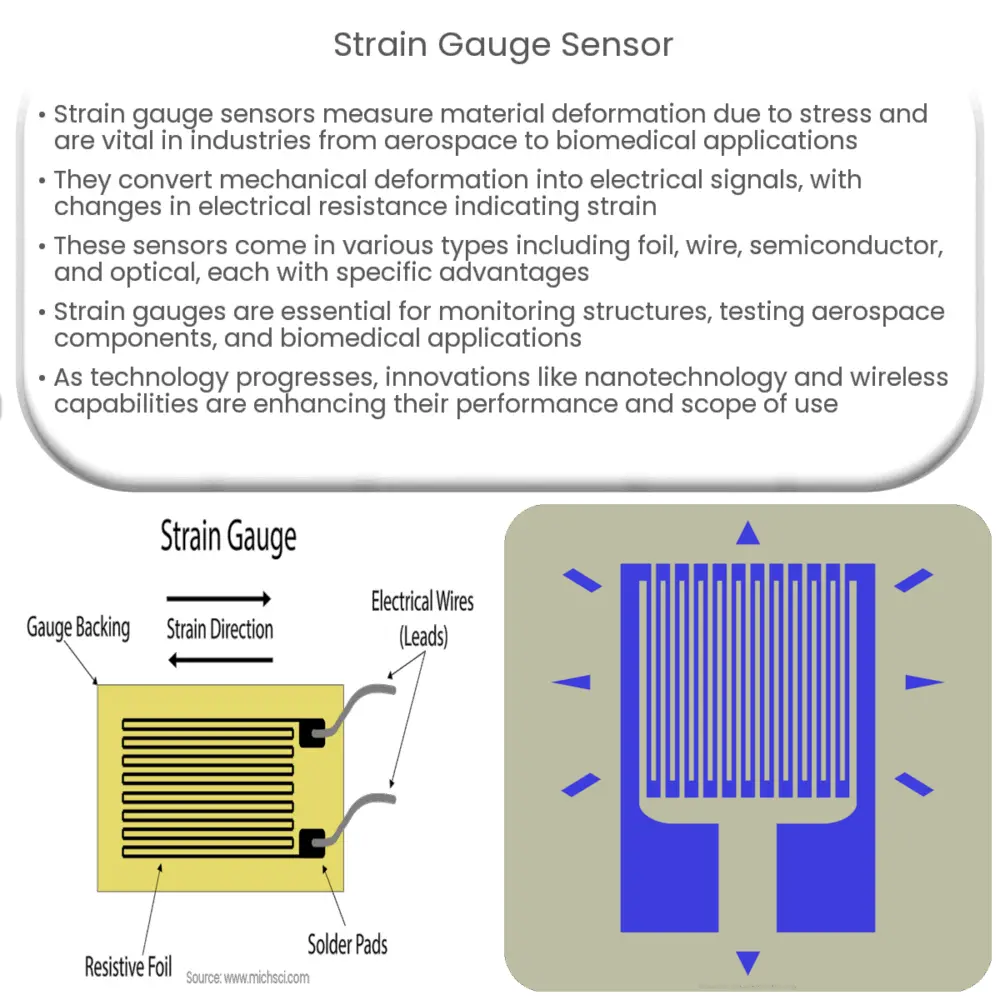Strain gauge sensors measure material deformation due to stress, offering reliable data for industries like automotive, aerospace, and civil engineering.

Strain Gauge Sensors: An Overview
Strain gauge sensors have become a fundamental component in various industries, ranging from automotive and aerospace to civil engineering and medical applications. These versatile sensors measure the deformation of a material due to applied stress, providing accurate and reliable data for monitoring and control systems. In this article, we will explore the working principles, types, and applications of strain gauge sensors.
Working Principle of Strain Gauge Sensors
A strain gauge sensor is a device that converts mechanical deformation, such as elongation or compression, into an electrical signal. This is achieved through a simple yet effective mechanism: as the strain gauge is subjected to stress, its electrical resistance changes proportionally. The fundamental principle behind this behavior is the piezoresistive effect, which describes how the electrical resistivity of a material changes as a result of applied mechanical stress.
Typically, a strain gauge consists of a thin, flexible backing material with a conductive pattern made of metallic foil or wire. The conductive pattern is arranged in a grid-like structure, allowing it to change its shape as the backing material deforms. The change in the conductive pattern’s geometry results in a proportional change in its electrical resistance, which can then be measured and correlated to the applied strain.
Types of Strain Gauge Sensors
Strain gauge sensors are available in various configurations and designs, each catering to specific application requirements. Some common types of strain gauges include:
- Foil strain gauges: These are the most common type of strain gauge, comprising a metallic foil pattern bonded to a thin insulating backing material. Foil strain gauges offer excellent sensitivity and are widely used in many applications due to their low cost and ease of use.
- Wire strain gauges: In these gauges, a thin wire is wound in a grid pattern and attached to a backing material. Wire strain gauges are more durable than foil gauges and can withstand higher temperatures, making them suitable for harsh environments.
- Semiconductor strain gauges: Semiconductor materials, such as silicon or germanium, are used to create these strain gauges. They offer higher sensitivity compared to metallic gauges, but are more susceptible to temperature fluctuations and are generally more expensive.
- Optical strain gauges: These gauges use fiber optic technology to measure strain. Optical strain gauges offer immunity to electromagnetic interference and can be used in high-temperature or chemically aggressive environments.
Each type of strain gauge sensor has its advantages and limitations, and the choice depends on factors such as sensitivity, temperature range, and environmental conditions.
Applications of Strain Gauge Sensors
Strain gauge sensors are employed across a broad spectrum of industries due to their versatility and precision. Some notable applications include:
- Structural health monitoring of buildings, bridges, and dams
- Load and force measurement in industrial machinery and equipment
- Aerospace component testing and monitoring
- Biomedical applications, such as measuring human body motion and prosthetics
As technology continues to advance, strain gauge sensors will undoubtedly play an increasingly important role in a wide array of applications, driving innovation and ensuring the safety and reliability of critical infrastructure and systems.
Installation and Measurement Techniques
Proper installation of strain gauge sensors is crucial for obtaining accurate measurements. There are several methods used for installing strain gauges, such as adhesive bonding, spot welding, and mechanical clamping. The choice of installation method depends on factors like the material being tested, environmental conditions, and the required measurement accuracy.
Once installed, the change in resistance of the strain gauge is typically measured using a Wheatstone bridge circuit. The Wheatstone bridge is an electrical circuit used to measure unknown electrical resistance by balancing two legs of a bridge circuit, one leg of which includes the strain gauge. The output voltage from the Wheatstone bridge is proportional to the applied strain, which can then be converted into a digital signal for further analysis and processing.
Challenges and Limitations
While strain gauge sensors offer numerous advantages, they also have some limitations and challenges:
- Temperature sensitivity: Strain gauges are sensitive to temperature changes, which can cause inaccurate readings. Temperature compensation techniques, such as using a dummy gauge or employing specialized materials, can help mitigate this issue.
- Creep: Over time, the strain gauge’s response may drift due to material relaxation, which can result in measurement errors. The use of high-quality materials and proper installation can minimize creep effects.
- Fatigue: Repeated loading and unloading can cause fatigue in the strain gauge material, leading to reduced accuracy and potential failure. Regular inspection and maintenance can help identify and address fatigue-related issues.
- Signal noise: Electrical noise can affect the accuracy of strain gauge measurements. Shielding and grounding techniques, as well as digital filtering, can help reduce noise-related issues.
Future of Strain Gauge Sensors
As technology evolves, new materials and methods are being developed to enhance the performance and capabilities of strain gauge sensors. Some emerging trends include:
- Nanotechnology: The development of nanomaterial-based strain gauges, such as carbon nanotubes and graphene, promises higher sensitivity, reduced size, and improved durability.
- Wireless technology: The integration of wireless communication modules allows for real-time, remote monitoring and control of strain gauge sensors, simplifying data acquisition and reducing installation complexity.
- Smart sensors: The incorporation of microprocessors and advanced algorithms enable strain gauge sensors to perform on-board data processing, self-calibration, and diagnostics, improving the overall accuracy and reliability of the system.
In conclusion, strain gauge sensors are an essential tool for measuring mechanical deformation and stress in various industries. As technology continues to advance, we can expect further improvements in the accuracy, reliability, and functionality of these versatile sensors, enabling new applications and solutions across a wide range of sectors.

